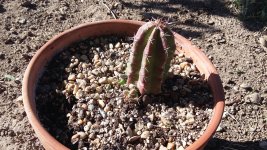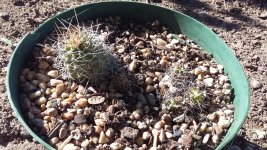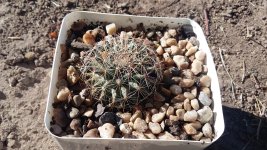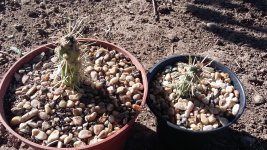Meet some of the newest members of the family. 8)
1. Echinocereus triglochidiatus "Inermis"
2. Echinocereus triglochidiatus "Utah"
3. Mammillaria Hyderi
1. Echinocereus triglochidiatus "Inermis"
2. Echinocereus triglochidiatus "Utah"
^ That should probably read phenethylamine derivative.E. triglochdiatus -
( Claret Cup Cactus ) From more arid regions but similar to Pitallito. Revered as a false Peyote by the Tarahumara. A hardy cluster mound forming species, growing to 60 cm. Has brilliant red cup shaped flowers and edible strawberry flavored fruit, much prized as a delicacy. There are reportedly several varieties, most of which are endangered in the wild. The variety arizonicus has been declared endangered in the U.S.A. in 1976. Widely distributed from Northern Chihuahua in Mexico to New Mexico, Northeast Arizona, Southern Colorado and Western Texas.
Reported to contain unspecified alkaloids. Plants rumored to contain 5-Meo-DMT.
Erowid Cacti Vaults : Visionary Cactus Guide - Mescaline from Sawdust
The San Pedro Fanatic - Visionary Cactus Guideerowid.org
This genus which comes from the words echinos, meaning “spiney” and cereus, meaning “wax candle”, makes up a large geneus of cacti which is both rich in both diversity and abundance (Weniger 1984). There are 20 to 30 species from South Dakota down to Mexico City, half of which occur only in Mexico (Benson 1982). Only two of these species are considered “hikuri” or false peyotes by the Tarahumara. These are Echinocereus triglochidiatus and E. salmdyckianus. While they contain a trypamine derivative (3-hdroxy-4-methoxyphenethylamine), it is apparently not as strong as other “hikuri” (Schultes et al 1998). Bye (1979) documented an interesting scenario when he was collecting specimens of the two aforementioned species. While cutting the stems and flowers, an old Tarahumara began singing to the flowers so that “the plants would not feel offended by my ruthless actions.”
http://www.thewildclassroom.com/biodiversity/floweringplants/extras/cactaceae hallucinogenics.htm
3. Mammillaria Hyderi
M. heyderi -
A ball shaped cactus with geometric rings of low triangular tubercles. This plant has white spines and gorgeous pink to red flowers with iridescent centers, and red fruit. Several different varieties known to exist.
Contains: N-methyl-3,4-dimethoxyphenethylamine.
M. heyderi var.hemisphaerica also contains the same psychoactive alkaloid.
Erowid Cacti Vaults : Visionary Cactus Guide - Mescaline from Sawdust
The San Pedro Fanatic - Visionary Cactus Guideerowid.org
The genus Mammillaria is a fairly large cacti genus with perhaps 100 species occurring from California to southern Nevada, southwestern Utah, New Mexico, Mexico, Texas and a few in the Caribbean (Benson 1982). Some texts separate some members of this genus into a separate genus called Dolichothele, but for the purposes of this review all will be lumped together.
Some of the most important ‘false peyotes’ of the Tarahamara Indians belong in this genus (Schultes1998). While several may contain alkaloids that have not been analyzed, there are at least seven that are known to contain psychoactive compounds. These include Mammilaria craigii, M grahmii, M. heyderii, M. longimamma, M. pectinifera, M. senilis.
One of the native cacti, M. craigii, has a long history of use in Mexico and is known from the Tarahumara as “wichuri” or “witculiki” (Bennet and Zingg 1935). Bruhn and Bruhn (1973) pointed out that this name was very peculiar as they discovered that the native term for crazy was, “wichuwa-ka.” The similarity in names is obvious and surely raised the question of how it was used. The plant is first roasted and the spines removed. Then the center is squeezed out, often into the ear. Ingestion of the plant by local shamans allowed them to ‘see’ into a person and find the demons that plagued any human (Bennet and Zingg 1935). The active compounds in this plant have been identified as N-methyl-3,4-dimethoxyphenethyl-amine (Bruhn and Bruhn 1973).
Another plant, M. grahamii, found in the region, is differentiated from M. craigii by the reddish central spines and the reddish vascular tissue in the plant stem (Bye 1979). It is known as “peyote” or by the Tarahumaras as “hikuri”. Apparently this plant was used in ceremonies where both the shaman and the participants would take the plant. It would allow them to “travel” with spectacular colors. Yet, like many of the “hikuri” species, if improperly used the Tarahumara’s report that it can cause one to go crazy (Bye 1979).
http://www.thewildclassroom.com/biodiversity/floweringplants/extras/cactaceae hallucinogenics.htm
4. Opuntia basilariusOpunita
Several species from this large Genus is used as an add-mixture to ayahuasca by several South American Indian tribes. A common type of Cacti, it grows naturally from Southern Canada, in the North, to the strait of Magellan in the South and has spread through introduction all over the world.
This species is separated into two distinct forms, the prickly pear type, ( pad shaped stems with no spines, has Glochida ) and the Cholla type, (cylindrical sections joined together in links, with large spines). Can be used as a base plant for grafting Peyote. There are over 160 known species of Opunita.
Erowid Cacti Vaults : Visionary Cactus Guide - Mescaline from Sawdust
5. Opuntia echinocarpaO. basilaris -
Contains: mescaline (.01%), 4-hydroxy-3-5-dimethoxyphenethylamine.
Erowid Cacti Vaults : Visionary Cactus Guide - Mescaline from Sawdust
6. Opuntia imbricataO. echinocarpa -
Contains: mescaline (.01%), 3-4-dimethoxyphenethylamine (.01%), 4-hydroxy-3-5-dimethoxyphenethylamine (.01%).
Erowid Cacti Vaults : Visionary Cactus Guide - Mescaline from Sawdust
O. imbricata -
Contains: mescaline, 3-methoxytyramine, 3-4-dimethoxy-phenethylamine, tyramine.
Native from Southwestern USA to Mexico.
Erowid Cacti Vaults : Visionary Cactus Guide - Mescaline from Sawdust






